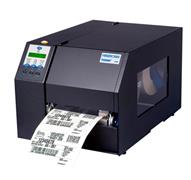KEY INFORMATION SECTION 3. In computing, a printer is a peripheral which produces a hard copyorprintout (permanent human-readable text and/or graphics) of documents stored in electronic

| 
| 
|
In computing, a printer is a peripheral which produces a hard copyorprintout (permanent human-readable text and/or graphics) of documents stored in electronic form, usually on physical print media such as paper or transparencies. Many printers are primarily used as local peripherals, and are attached by a printer cable or, in most newer printers, a USB cable to a computer which serves as a document source. Some printers, commonly known as network printers, have built-in network interfaces (typically wireless or Ethernet), and can serve as a hardcopy device for any user on the network. In a network, users can share a printer connected to a print server, a computer that stores the files waiting to be printed. Individual printers are often designed to support both local and network connected users at the same time.
In addition, a few modern printers can directly interface to electronic media such as memory sticks or memory cards, or to image capture devices such as digital cameras, scanners; some printers are combined with scanners and/or fax machines in a single unit, and can function as photocopiers.
| Printers that include non-printing features are sometimes called Multifunction Printers (MFP), Multi-Function Devices (MFD), or All-In-One (AIO)printers. Most MFPs include printing, scanning, and copying among their features. A Virtual printer is a piece of computer software whose user interface and API resemble that of a printer driver, but which is not connected with a physical computer printer. | 
|
A program in your computer, called the printer driver, converts data into a form that your printer can understand. A print spooler stores files to be printed when the printer is ready. It lets you change the order of documents in the queue and cancel specific print jobs.
The output quality, or resolution, is measured in dpi or dots per inch.
The speed of your printer is measured in pages per minute (ppm).

| A dot-matrix printer uses a group, or matrix, of pins to create precise dots required to shape a character. A print head containing tiny pins strikes an inked ribbon to make letters and graphics. They print text and graphics and nowadays some of them can print up to 500 characters per second (cps). They are slower than laser printers but much cheaper. This |
impact printing technology allows shops, for example, to print multi-part forms such as receipts and invoices, so it's useful when self-copying paper is needed. It has two important disadvantages: noise and a relatively low resolution (from 72 to 180 dpi).
An ink-jet (also called bubble-jet) printer generates an image by spraying tiny, precise drops of ink onto the paper. This is non-impact printing technology. The resolution ranges from 300 to
| 1200 dpi, suitable for small quantities or home use. This type of printer is quite fast, silent and not so expensive as a laser printer. A standard ink-jet has a three-colour cartridge, plus a black cartridge. Professional ink-jets have five-colour cartridges, plus black; some can print in wide format, ranging from 60 cm up to 5 metres (e.g. for printing advertising graphics). | 
|
A laser printer uses a laser beam to fix the ink to the paper. A laser works like a photocopier – it

| scans the image with a laser beam and transfers it to paper with a special ink powder called toner which is attracted to paper by an electrostatic charge and then fused on by a hot roller. Laser printers are fast and produce a high resolution of 1,200 to 2,400 dpi, so they are ideal for businesses and for professional graphics work. They are constantly being |
improved. Lasers use a page description language or PDL which describes how to print the text and draw the images on the page. The best-known languages are Adobe PostScript and HP Printer Control Language.
A professional imagesetter is a typesetting printer that generates very high-resolution output (over 3540 dpi) on paper or microfilm. It's used for high-quality publications in desktop publishing. In addition, it is extremely fast. Although it produces the highest quality output, it has one important drawback: it is too expensive for homes or small offices.
Thermal transfer printers use solid sticks of colored ink (similar in consistency to candle wax), which are melted and fed into a piezo crystal operated print-head which sprays the ink on a rotating, oil coated drum. The paper then passes over the print drum and the image is transferred, or transfixed, to the page. Drawbacks of the technology include high power consumption and long warm-up times from a cold state.
| Thermal printers work by selectively heating regions of special heat-sensitive paper. They are silent and considered to be inexpensive. Monochrome thermal printers are used in cash registers, ATMs, gasoline dispensers and some older inexpensive fax machines. Colors can be achieved with special papers and different temperatures and heating rates. | 
| |

| A plotter is a vector graphics (using geometrical primitives such as points, lines, curves, and shapes or polygon(s), which are all based on mathematical equations, to represent images in computer graphics) printing device which uses ink and fine pens held in a carriage to draw detailed designs on paper. It's used in computer-aided design, maps, 3-D technical illustrations, construction plans, engineering drawings and other technical illustrations. | |
Дата добавления: 2015-07-30; просмотров: 1489;
